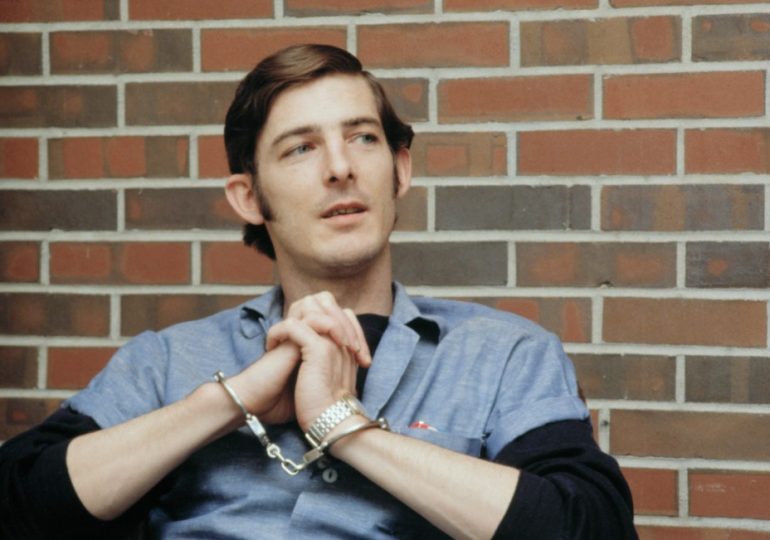A CONVICTED killer met his end in the most gruesome of ways, after being slowly “fried” from the inside out in a botched execution.
It took three jolts of electricity and 14 minutes to kill John Louis Evans as the electric chair he was sitting in malfunctioned.
GettyJohn Louis Evans’ execution took three jolts of electricity and 14 minutes[/caption]
AP:Associated PressEvans was put to death on Alabama’s infamous Yellow Mama electric chair in 1983[/caption]
AlamyConvicted murderer Kenneth Eugene Smith’s execution by nitrogen gas was also ‘botched’ in Alabama this week[/caption]
The inmate, executed in the southeastern US state of Alabama in 1983 when he was aged 33, had robbed and killed pawn shop owner Edward Nassar while his two young daughters were in the store.
Members of the public and the media called for Evans to be given the death penalty, as Alabama had passed a law reinstating capital punishment in 1976.
The sentence was carried out at Holman Prison using an electric chair dubbed “Yellow Mama”, because of its traffic-yellow coat of paint, that was built by an inmate in 1927.
It had not been used since 1965 but was brought back to operational life for Evans’ execution.
The pawnbroker-killer’s death required three applications of electricity over a prolonged period, despite his lawyer’s protests on the grounds of cruel punishment.
After the first jolt of electricity was administered, sparks and flames are said to have erupted from the electrode attached to Evans’ leg; it burst from the strap holding it in place and caught fire.
Smoke and sparks then emerged near Evans’ left temple, but the killer still had a heartbeat, so the electrode was reattached to his leg and another jolt of electricity was applied.
Again, doctors found a heartbeat. A third and final jolt of electricity was applied.
Eyewitnesses described the “stench of burning flesh” as “nauseating”.
Evans’ attorney Russell Canan later recalled: “His body slammed against the straps holding him in the electric chair and his fist clenched permanently.
“The electrode apparently burst from the strap holding it in place. A large puff of greyish smoke and sparks poured out from under the hood that covered Mr. Evans’s face.
“An overpowering stench of burnt flesh and clothing began pervading the witness room.
“More smoke emanated from his leg and head. Again, the doctors examined Mr. Evans. The doctors reported that his heart was still beating, and that he was still alive.
“At 8:44, the doctors pronounced him dead. The execution of John Evans took fourteen minutes.”
Evans had admitted to a jury that he killed his victim in 1977, claiming he felt the pawnbroker was going to grab a weapon and fire at him.
He also confessed to a string of other crimes including more than 30 armed robberies, nine kidnappings, and two extortion schemes.
Prosecutors reportedly rejected his guilty plea as they wanted to secure an execution through conviction by a jury.
The death penalty was supposedly ordered in light of Evans stating he did not feel remorse and would kill again under the same circumstances.
He also threatened to escape and kill each member of the jury if they did not sentence him to death.
In a similar case of a “botched” execution, convicted murderer Kenneth Eugene Smith, 58, was killed on Thursday by nitrogen gas, also in the state of Alabama.
Witnesses claimed he suffered in agony for a total of 22 minutes before the gas began to flow in a display one journalist described as the “most violent execution” he had ever seen.
Moments before inhaling the nitrogen gas through a face mask, similar to that which a firefighter would wear, Smith said: “Tonight, Alabama causes humanity to take a step backward.
“Humanity rose up … I am leaving with love, peace, and light … I love you. Thank you for supporting me. I love all of you.”
He proceeded to sign “I love you” with his left hand as his family watched from the window of the death chamber.
The Alabama Attorney General’s Office expected Smith to lose consciousness quickly after the gas began to flow, but he remained alert for several minutes, according to witnesses.
He reportedly shook and writhed in the gurney, ripping his head back and forth for about two minutes from when the gas was released, then breathed heavily for five to seven minutes before dying.
The state had described the method of execution by nitrogen gas as “the most painless and humane method of execution known to man”.
America’s most notorious executions
The issue of the death penalty in the US has been cast back into the spotlight following the execution of Kenneth Eugene Smith
The US Sun has a rundown of some of the most notorious executions, including ones that did not go to plan.
Jesse Tafero
Tafero was sentenced to the death penalty after he was wrongly accused of shooting two police officers in 1976.
His death was anything but ordinary as the electric chair he was strapped to malfunctioned three times and his head burst into six-inch flames.
“It takes seven minutes before the prison doctor pronounced him dead, seven minutes of heaving, nodding, flame, and smoke,” one eye witness later said.
Clayton Lockett
Lockett was sentenced to death for murder and rape in 2000 but his 2014 execution was called off after it was botched.
Nine failed attempts were made to inject potassium chloride into his veins until officials put the needle into his groin.
The injection slowed his heart instead of fully stopping it before a doctor placed the needle into an artery, which caused blood to squirt over him.
The execution was called off but Lockett died of a heart attack on his way to the hospital.
George Stinney
The 14-year-old was sentenced to death in 1944 for the murder of two girls, despite a lack of evidence.
Stinney was too small to fit into the electric chair so he had to sit on books but he survived the first round of 2,400 volts.
Prison guards had to use two more electric shots to kill the teen.
Stinney’s conviction was overturned by a South Carolina court in 2014, 70 years after he was executed.
John Evans
Evans had shot and killed an Alabama pawnshop owner in 1977 during a fumbled raid of the store.
He initially survived the first shocks of 1,900 volts but an electrode came loose resulting in a gruesome scene.
“A large puff of greyish smoke and sparks poured out from under the hood that covered Mr. Evans’s face,” his lawyer said.
“An overpowering stench of burnt flesh and clothing began pervading the witness room.”
Evan’s heart was still beating after the second electrocution and he finally died following the third shock, in a 14-minute ordeal.
Pedro Medina
Medina, a Cuban refugee, was convicted of murdering his neighbor Dorothy James in 1982.
He died in an electric chair 15 years later but a journalist reported his gruesome ordeal.
“Blue and orange flames up to a foot long shot from the right side” of his head,” the reporter said.
“They’re burning him alive,” witness Michael Minerva also said.
Journalist Lee Hedgepeth, who was present on the day, told the BBC of Smith’s reaction to the gas: “Kenny begins to violently shake against the straps that are holding him.
“That violent shaking lasts for about four or five minutes.
“I’ve witnessed five executions in Alabama, four of them lethal injection, one with nitrogen, and this was the most violent execution I have ever seen.”
It was the first time a new execution method had been used in the US since the lethal injection was introduced in 1982.
Smith was one of two men convicted of the murder-for-hire killing of Elizabeth Sennett in 1988.
Prosecutors said he and his accomplice were each paid $1,000 to kill the woman on orders from her pastor husband who was in debt and wanted to collect on her life insurance.
Elizabeth’s husband, Charles Sennett Sr, killed himself when the investigation named him as a suspect, according to court documents.
Smith was supposed to be killed by lethal injection in 2022 but the execution was called off when prison officials determined they did not have enough time to set a second IV line before the death warrant expired at midnight.
The killer’s attorneys claimed he had been strapped to the gurney at 8pm and was not removed until four hours later, stating: “an IV team entered the execution chamber and began repeatedly jabbing Mr. Smith’s arms and hands with needles, well past the point at which the executioners should have known that it was not reasonably possible to access a vein.”
The Alabama Prisons Commissioner said: “the people attempting to carry out the execution had tried to insert a line into ‘several locations’ without success.”
John Forrest Parker, the other man convicted of Sennett’s murder, was executed in 2010.
Three per cent of US executions are estimated to have been botched between the years 1890 and 2010.
A professor of jurisprudence and political science at Amherst College, Austin Sarat, reported that 276 of a total 8,776 executions over the 120-year period went wrong in some way.
Problems with the executions ranged from inmates catching fire while being electrocuted, such as in Evans’ case, to them being strangled during hangings, rather than having their necks broken.
Evans’ execution in an electric chair was the first in Alabama since 1965Getty
EPAGuards man the gate outside the WC Coleman Correction Facility where Kenneth Smith was killed on Thursday[/caption]
APAnti-death penalty signs placed by activists stand along the road to the correctional facility ahead of Smith’s execution[/caption]
EPASmith’s spiritual adviser Reverend Dr Jeff Hood comforts the killer’s wife Deanna Smith as she describes the execution[/caption]
Leave a comment








